|
From the Director: Welcome to 2021 Science Highlights
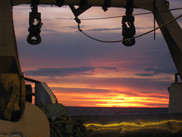
The NOAA Fisheries mission is broad and includes fisheries, aquaculture, protected species, habitats, and human activities and communities all within an ecosystem context. As a result of our broad mission, our science represents a diversity of activities. This month we feature shark tagging, our Gulf of Maine bottom longline survey, spiny dogfish diet, sea scallop aquaculture, and more. The people who conduct and support our science are talented and diverse. One thing we all hold in common is a commitment to public service. As a way to introduce some of the people who work at the Center, this month we highlight Kate Zewinski, who works in our shark program. I hope you find these highlights useful in understanding the work and people at our Science Center.
Cheers, Jon Hare
|
2020 Fall Gulf of Maine Bottom Longline Survey Wraps Up
Research Track Assessments Underway
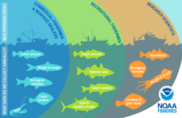
January is a busy month for our research track working groups! The Illex Squid Working Group met on January 5th. The Haddock Working Group is meeting on January 7th and 11th, while the Butterfish Working Group meeting is scheduled for January 21st. You will find agendas, terms of reference, a list of working group members, and information on how to join the meetings on the links above. The research track assessment for haddock will be peer reviewed in July 2021 and the research track assessments for Illex and butterfish will be peer reviewed in November 2021.
|
Cooperative Research: Facing the Challenges of COVID-19 Workshop Series
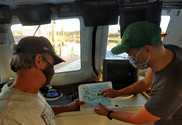
The novel coronavirus has presented challenges to researchers and fishermen, who work in close quarters at sea and shore-side. Some of our cooperative research partners have developed strategies to navigate the COVID-19 pandemic and continue their work safely. To share what has been learned, our Cooperative Research Branch is hosting two virtual workshops on February 25 and March 4, 2021. The first webinar in this series will focus on how field work was adapted to ensure safe operations during the COVID-19 pandemic. The second webinar will focus on how fishermen worked with researchers to independently collect scientific data during the pandemic, and how it may be used to bridge data gaps.
|
Helping Maine’s Pioneering Sea Scallop Farmers
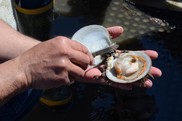
Enterprising fishermen have been developing sea scallop aquaculture in Maine with technology adapted from Japan. Scallop farming is new to Maine, and growers need to know which environments have the right conditions for the scallops to filter feed and thrive. In 2019 our Milford Laboratory scientists conducted a habitat suitability study for cultured scallops in the Damariscotta River to assist this effort. They conducted feeding studies, and measured water temperatures and the amount and quality of available food to help determine site selection. Like many research efforts, this one was a partnership and involved two public meetings to get feedback from the industry about how NOAA Fisheries could help.
|
PEP Program Call for Applicants: Deadline February 13
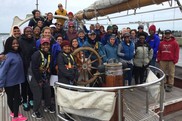
The Woods Hole Partnership Education Program (PEP) is seeking applicants for its 10-week summer program that combines undergraduate course work with research in marine and environmental sciences. Launched in 2009, PEP promotes a diverse scientific community. It recruits college talent from all backgrounds, but especially from minority groups that are under-represented in marine and environmental sciences. African American, Hispanic American, Native American, Asian Pacific Island, and Alaska Native students are particularly encouraged to apply. For PEP’s first 11 years, its students came to Woods Hole. Their summer was filled with course work, research projects, research cruises, and a variety of career-building workshops, symposia, and field trips. In 2020, the program was offered virtually, with excellent results. A decision will be made on this year’s format by May 1.
|
Science on the Half Shell: Milford Lab Tour for Kids Grades 2-8

During this NOAA Live! Webinar kids meet NOAA scientists from the Northeast Fisheries Science Center's Lab in Milford, CT, who study shellfish and investigate questions that help shellfish growers around the world. You learn about what oysters eat and how they are helping make a cleaner Long Island Sound. You also see through real fish surveillance how shellfish farms can become habitat for other species. This webinar is part of a series developed for families, and each features a different NOAA expert/topic and a moderated question and answer session so you can get a peek at what our scientists do. For more episodes visit NOAALive!
|
Shark Tagging Interest Grows in Pandemic
Speaking of Sharks: Meet Kate Zewinski
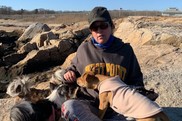
Not many people can say they've returned to a place of employment three times. For Katrina "Kate" Zewinski, her family's connections to commercial fishing and an internship brought her to NOAA Fisheries and a job she loves. Kate is the tagging and data gatekeeper for our Cooperative Shark Tagging Program.
|
Spiny Dogfish Eat Atlantic Cod: DNA May Provide Some Answers
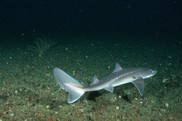
As dogfish populations recover from overfishing, questions remain about how much Atlantic cod they are eating and its impact on the struggling cod population. Commercial fishermen in our Study Fleet collected the dogfish samples, and Center researchers used innovative genetic techniques to help shed some light on the situation. While rates of interaction between cod and spiny dogfish are higher than previously thought, further study is needed to find out just how much cod dogfish eat. Studies are ongoing to better integrate predator-prey relationships into stock assessment models used to estimate both current and future fish population numbers.
|
Seriously Useful Seafood Tips Part 2: Shellfish and Other Farmed Seafood
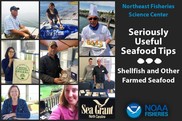
Our stakeholders, collaborators, and partners working in our region’s farmed seafood industry definitely know a thing or two when it comes to serving up seafood. In part two of our series on seafood tips from the pros, we asked eight of them to share some of their best practices to help the home consumer.
|
#ShowUsYourSeafood Challenge: Results Are In!
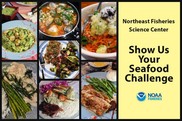
Staff at the Northeast Fisheries Science Center participated in a recipe contest to help support NOAA Fisheries’ #EatSeafoodAmerica campaign. The competition was fierce. Judging was tougher. These seven dishes rose above the rest.
|
2021 CINAR/QUEST Fellows Named
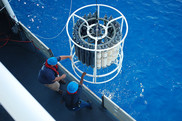
Five people have just been appointed to two-year fellowships by the Cooperative Institute for the North Atlantic Region (CINAR), led by the Woods Hole Oceanographic Institution and the Northeast Fisheries Science Center. Each fellow is working in the field of quantitative fisheries and ecosystems science (QUEST). These fellowships support early career faculty at CINAR partner institutions who are working on QUEST-related issues and who are committed to education and training. Each fellow is paired with scientists at the Northeast Fisheries Science Center to further strengthen the links between research, assessments, and management. These fellowships are jointly funded by the NOAA Fisheries QUEST Program, the Northeast Fisheries Science Center, and CINAR’s Education Program.
|
Creature Craft Feature Tops our 2020 Internet Chart
Five Standout 2020 NEFSC Stories in a Mind-Blowing Year
|
|
Upcoming Events
COVID-19: We continue to plan events, but they may be delayed, cancelled, or moved to a virtual platform closer to their date.
Jan 7 Haddock Research Track Assessments Working Group Meeting
Jan 7 Atlantic Large Whale Take Reduction Team Telemeeting
Jan 19 Educator Workshop: Green Careers for a Changing Climate
Jan 20 Educator Webinar: Green Infrastructure Efforts
Jan 21 Butterfish Research Track Assessment Working Group Meeting
Feb 13 Application Deadline for 2021 Woods Hole Partnership Education Program
Feb 25, Mar 4 Cooperative Research: Facing the Challenges of COVID-19 Virtual Workshops
|
|
|
|
|